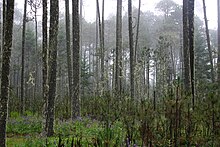Sierra Madre de Oaxaca pine–oak forests
This article needs additional citations for verification. (April 2010) |
| Sierra Madre de Oaxaca pine–oak forests | |
|---|---|
 Cerro San Felipe, located in Benito Juárez National Park, is important as the water source for the city of Oaxaca | |
 Location of the Sierra Madre de Oaxaca pine–oak forests ecoregion | |
| Ecology | |
| Realm | Neotropical |
| Biome | tropical and subtropical coniferous forests |
| Borders | |
| Bird species | 447[1] |
| Mammal species | 176[1] |
| Geography | |
| Area | 14,300 km2 (5,500 sq mi) |
| Country | Mexico |
| Conservation | |
| Conservation status | Critical/endangered[2] |
| Habitat loss | 15.078%[1] |
| Protected | 6.43%[3] |
The Sierra Madre de Oaxaca pine–oak forests is a tropical and subtropical coniferous forests ecoregion in Southern Mexico.
It occupies the Sierra Madre de Oaxaca, a mountain range which lies mostly within the state of Oaxaca, and extends north into Puebla and Veracruz states. It is one of a chain of pine–oak forest ecoregions extending along the American Cordillera from Oregon and California in the north to Nicaragua in the south.

Geography
The ecoregion covers an area of 14,300 square kilometers (5,500 sq mi), lying above 1,600 metres (5,200 ft) elevation. The Sierra Madre de Oaxaca runs northeast-southwest, extending 300 kilometres (190 mi) from Pico de Orizaba in the northeast to extends to the Isthmus of Tehuantepec in the southeast. Peaks in the Sierra Madre de Oaxaca average 2,500 metres (8,200 ft) meters in elevation, with some peaks exceeding 3,000 metres (9,800 ft). The range intercepts humid air moving west from the Gulf of Mexico.
Adjacent ecoregions
The
Flora
The associated vegetation of the pine–oak forests varies with elevation and exposure. Besides the

Fauna
The forests of the Sierra Madre de Oaxaca are one of the last remaining habitats with jaguar and puma in Mexico.
People
The pine–oak forests of the Sierra Madre de Oaxaca have been inhabited for a millennia by indigenous cultures. The primary cultures are of the
Conservation and threats
Some of the Sierra Madre de Oaxaca pine–oak forest
Most conservation in the Sierra Madre de Oaxaca is controlled by indigenous communities. For example, Santiago Comaltepec's vast expanse of cloud forests is considered some of the best conserved cloud forests in the world. Many communities, notably Ixtlán de Juárez and the Pueblos Mancomunados, among others, strive to conserve their forest through projects including sustainable forestry and selective logging, ecotourism, education projects, and the prohibition of private property within their communities (thus hampering unsustainable development and industry by foreign or outside agents).
The forests are under threat by foreign investment, and by mining and logging commissions to foreign companies from the Oaxaca state government.
Protected areas
6.43% of the ecoregion is in
See also
- Conifers of Mexico
- List of ecoregions in Mexico
- Sierra Madre de Oaxaca topics
- Trees of Southern Mexico
References
- ^ a b c
Hoekstra, J. M.; Molnar, J. L.; Jennings, M.; Revenga, C.; Spalding, M. D.; Boucher, T. M.; Robertson, J. C.; Heibel, T. J.; Ellison, K. (2010). Molnar, J. L. (ed.). The Atlas of Global Conservation: Changes, Challenges, and Opportunities to Make a Difference. ISBN 978-0-520-26256-0.
- ^ a b "Sierra Madre de Oaxaca pine-oak forests". Terrestrial Ecoregions. World Wildlife Fund.
- ^ "Sierra Madre de Oaxaca pine-oak forests". DOPA Explorer. Accessed 15 September 2021. [1]
External links
- "Sierra Madre de Oaxaca pine-oak forests". Terrestrial Ecoregions. World Wildlife Fund.
